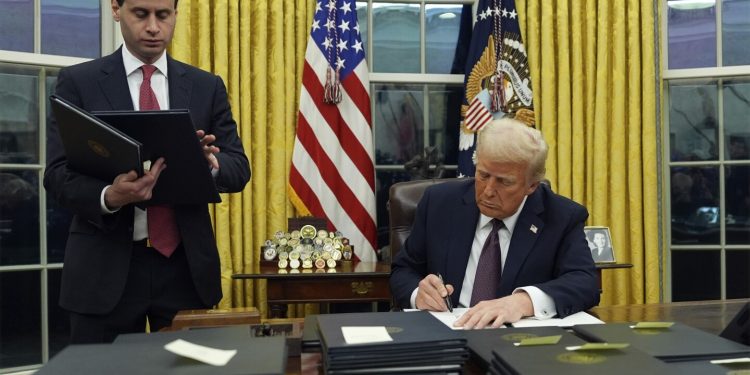A decree President Donald Trump signed a new federal gender definition on his first day back in office that could have a major impact on transgender people nationwide.
The order calls on the federal government to define gender as solely male or female and for that to be reflected on official documents such as passports and policies such as federal prison assignments. When it comes to federal spending, it’s unclear what his promise to end broader gender classifications will mean on the ground.
Many provisions will likely be challenged in court.
Here is an overview of the order.
Defining male and female based on cells that do not exist at the time of conception
THE order states that there are only two sexes, male and female. It rejects the fact that people can transition from one gender to another or be considered anything other than male or female, as non-binary, which describes people who do not identify as strictly male or female, or intersex.
This position reflects what many social conservatives have called for – and conflicts with what the American Medical Association and other mainstream medical groups say: that extensive scientific research suggests that sex and gender are best understood as a spectrum than as a definition of one or the other.
Trump’s order says it is intended to protect women’s spaces from those who “identify” as women.
It defines the sexes in an unconventional way, based on reproductive cells: large cells in females or small cells in males. And this suggests that humans have these cells from conception.
Biologists say this is a problem because eggs develop several weeks later and sperm are produced at puberty, not at conception.
“At this point, sexual differentiation has not started to occur,” said Carl Bergstrom, an evolutionary biologist at the University of Washington. “I see no logical and consistent way to interpret the definition in this decree, given the addition of the phrase ‘by design’.”
Bergstrom said a scientific explanation could specify sex chromosomes, but the executive order appears to deliberately avoid that, likely to get around the range of variations that include intersex peoplewho have physical traits that do not fit typical definitions of masculine or feminine categories.
What parts of the ordinance are in effect?
The order was signed, but much of it requires more federal action.
“Nothing is in effect,” said Heron Greenesmith, deputy policy director at the Transgender Law Center.
The executive order directs a White House staffer to draft a bill for Congress within 30 days that would codify the definitions into law.
Federal agencies must notify the president within 120 days of what they have done to comply with the order. Some parts may require going through the regulatory process or passing new laws.
Omar Gonzalez-Pagan, an attorney with Lambda Legal, said on a call with reporters this week that the order does not change current law but rather creates “a clear signal and a road map of where the policies are of this administration as it relates to transgender people.”
State laws on sports participation, restroom use, gender-affirming care, and other issues are not directly affected.
What does this mean for federally issued documents?
The order requires that passports, visas and Global Entry cards reflect the administration’s definition of gender.
The State Department, which is responsible for passports, declined to answer questions about the current status of the policy. The order suggests removing the “X” designation available on passports since 2021 after a long legal battle led by a intersex activist.
A department webpage describing how people could change their gender marker was taken offline, and Chase Strangio, an ACLU attorney, said a new request to change the marker was unlikely gender on a passport is approved.
What about transgender inmates in federal prisons?
The order contains specific details about how it should apply in federal prisons, which house nearly 2,300 transgender inmates, or about 1.5 percent of the total population.
It calls for housing transgender women — there are more than 1,500 — in men’s prisons and ending gender-affirming medical care.
At least two transgender inmates have undergone government-funded gender-affirming surgery in recent years, following court orders. More received other treatments, such as hormones.
Sarah Warbelow, legal director of the Human Rights Campaign, said court orders granting inmates access to treatment remain in effect, even if federal policy changes.
The ACLU says some defense attorneys said incarcerated transgender women were placed in solitary confinement or told they would be transferred to men’s prisons.
The Bureau of Prisons did not respond to questions about whether inmates should be moved.
Will this prevent Medicaid from funding gender-affirming care?
Medicaid, a joint federal-state health insurance program for low-income people, covers gender-affirming care in some states.
Former President Joe Biden’s administration passed a rule to make this happen nationwide. But the judges put that on hold.
So far, it’s unclear what might happen to coverage in states that have chosen to offer it.
Lindsey Dawson, director of LGBTQ health policy at the health policy research organization KFF, said eliminating coverage where it’s already in place would likely involve a long process — and, as others, would likely be subject to legal challenges.
___
The Associated Press Health and Science Department receives support from the Howard Hughes Medical Institute’s Science and Education Media Group and the Robert Wood Johnson Foundation. The AP is solely responsible for all content.


